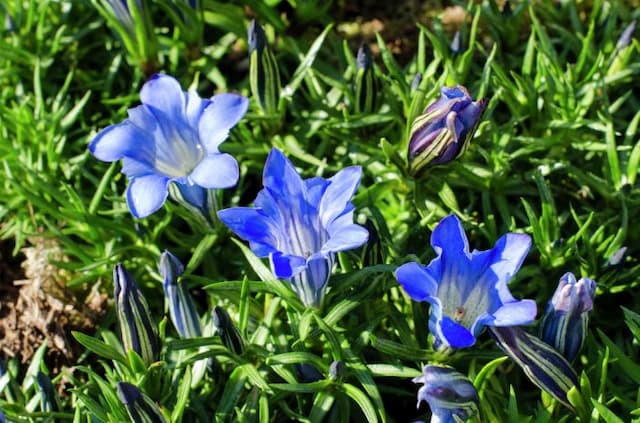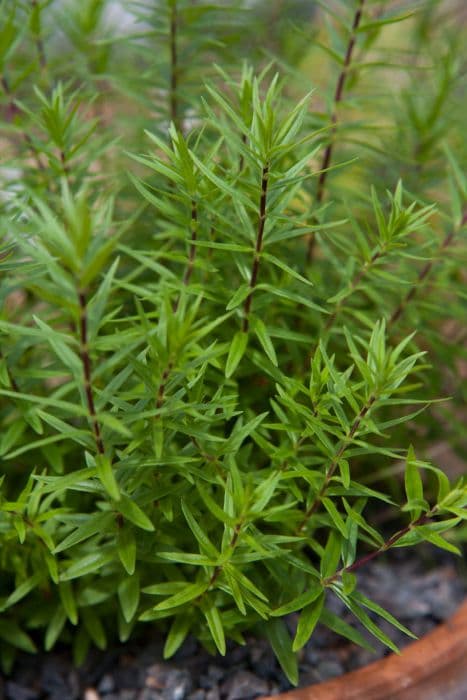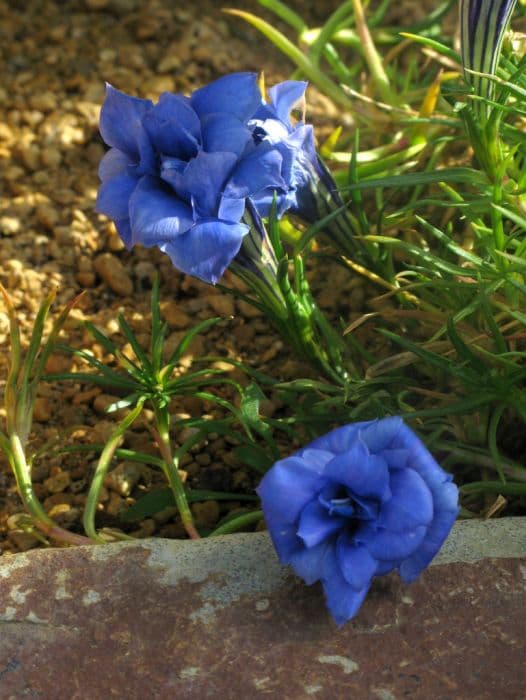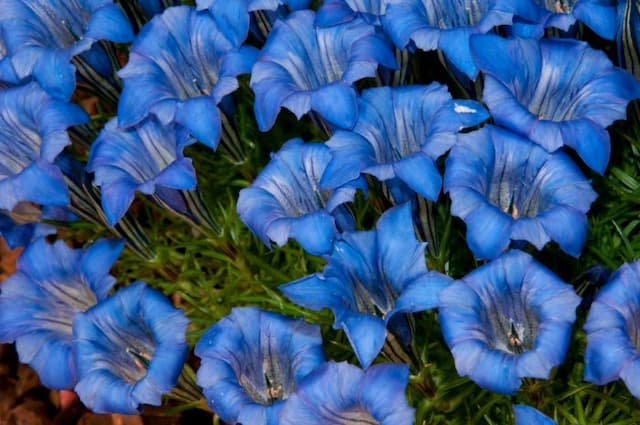Common Centaury Centaurium erythraea

ABOUT
Centaurium erythraea, commonly known as common centaury, is a small, herbaceous plant characterized by its vibrant green foliage and eye-catching pink flowers. The leaves of the common centaury are simple and oppositely arranged, usually forming a basal rosette at the ground level. These leaves are lance-shaped, exhibiting a smooth texture and distinct midrib that runs through the center. The stems are upright and slender, bearing clusters of star-shaped flowers at the top. Each flower consists of five pointed petals that spread outwards, resembling a miniature pink starburst. The flowers' color can range from soft pale pink to a more vivid magenta, often with contrasting yellow stamens at the center that add to their charm. Additionally, the common centaury may also display tiny, delicate seed capsules that follow the blooming period. Overall, the common centaury presents itself as a dainty and elegant plant, with a clumping growth habit that allows it to blend gracefully into meadows, grasslands, and garden settings where it can add a pop of color and natural beauty without dominating the landscape. Its aesthetic appeal lies in its simplicity and the harmonious arrangement of its leaves and blooms.
About this plant
 Names
NamesSynonyms
European Centaury, Common Centaury, Century, Bitter Bloom, Feverwort, Gentleman's Bitters, Lesser Centaury.
Common names
Centaurium minus, Erythraea centaurium, Erythraea pulchella, Erythraria centaurium, Centaurium pulchellum, Centaury erythraea, Chironia centaurium, Chironia erythraea, Centaurium vulgare, Erythraria pulchella.
 Toxicity
ToxicityTo humans
Common centaury (Centaurium erythraea) is not widely recognized as a toxic plant to humans. Traditionally, it has been used in herbal medicine for various ailments due to its bitter properties, and it is generally considered safe when used in appropriate quantities. However, as with many herbal remedies, excessive consumption may lead to adverse effects, and it's always advisable to use such herbs with caution and under professional guidance, especially for individuals with pre-existing health conditions or for those who are pregnant or breastfeeding. There is no well-documented case of poisoning from common centaury, so the typical symptoms of poisoning are not established.
To pets
Common centaury (Centaurium erythraea) is not universally documented as a toxic plant to household pets such as dogs and cats. While it is primarily a concern for pet owners to be cautious about exposing their animals to plants, Centaurium erythraea does not have a notable reputation for being poisonous to pets. No specific symptoms of common centaury poisoning in pets have been well-documented, but as with any non-food plant, ingestion by pets could potentially result in gastrointestinal upset or other mild reactions. It is always recommended to seek veterinary advice if you suspect your pet has ingested any plant material that is not part of its normal diet.
 Characteristics
CharacteristicsLife cycle
Biennials
Foliage type
Deciduous
Color of leaves
Green
Flower color
Pink
Height
1 foot (30 cm)
Spread
1 foot (30 cm)
Plant type
Herb
Hardiness zones
4
Native area
Europe
Benefits
 General Benefits
General Benefits- Pollinator Attraction: Centaurium erythraea, commonly known as common centaury, is known for attracting a variety of pollinators including bees, butterflies, and other beneficial insects, promoting biodiversity.
- Aesthetic Appeal: With its delicate pink flowers, common centaury adds beauty to gardens and wildflower meadows, making it a popular choice for ornamental planting.
- Culinary Use: The bitter taste of common centaury has been utilized in traditional European cuisine, especially in the preparation of certain liquors and bitters.
- Traditional Dye: Historically, the plant has been used to produce a natural dye, which can impart a red or pink hue to fabrics and other materials.
- Soil Indicator: The presence of common centaury can indicate certain soil conditions, such as poor fertility or compacted ground, providing insight for gardeners and conservationists.
- Herbal Tea Ingredient: Common centaury is often used as an ingredient in herbal teas, appreciated for its flavor and as part of traditional herbal blends.
- Wildlife Habitat: By creating a natural environment, common centaury can provide habitat and food sources for various insects, which in turn support local wildlife ecosystems.
 Medical Properties
Medical Properties- Antioxidant activity: The plant contains compounds that may help protect cells from damage by free radicals.
- Gastrointestinal aid: Centaurium erythraea is traditionally used to alleviate various digestive issues such as dyspepsia and loss of appetite.
- Anti-inflammatory effects: It may help reduce inflammation, contributing to its use in treating conditions like gastritis.
- Hepatoprotective properties: There is some evidence that the plant might help protect the liver from certain types of damage.
- Antimicrobial properties: Extracts from the plant have been shown to possess antibacterial and antifungal activities.
- Antipyretic effect: The plant has been used to reduce fever, though specific scientific evidence supporting this use is limited.
 Air-purifying Qualities
Air-purifying QualitiesThis plant is not specifically known for air purifying qualities.
 Other Uses
Other Uses- Dye: Centaurium erythraea has been historically used to extract a red dye, which is derived from the roots of the plant.
- Insect repellent: The strong scent of Centaurium erythraea may be used to repel certain insects when planted in gardens or when applied in a formulation.
- Gardening: As an ornamental plant, Common centaury adds vibrant color and variety to wildflower gardens and can be used in butterfly gardens to attract pollinators.
- Folklore rituals: In some cultures, Common centaury is included in rituals or carried as an amulet for good luck or protection.
- Educational tool: Common centaury is sometimes used in educational settings to teach botany, particularly the structure of dicotyledonous plants.
- Photography: Its bright flowers make it a popular subject for nature photographers and plant enthusiasts.
- Culinary garnish: Though not widely known for its culinary uses, the delicate flowers of Common centaury can be used as an edible garnish in some recipes.
- Natural indicator: The plant has been used in traditional practices to indicate soil health, as it thrives in well-drained, calcium-rich soils.
- Bioremediation: Research may explore the use of Common centaury in bioremediation to restore contaminated land due to its potential for accumulating certain metals.
- Floral arrangements: Dried Common centaury is sometimes used in floral arrangements and potpourri for its aesthetic appeal and pleasant scent.
Interesting Facts
 Feng Shui
Feng ShuiThe plant Centaury is not used in Feng Shui practice.
 Zodiac Sign Compitability
Zodiac Sign CompitabilityThe plant Centaury is not used in astrology practice.
 Plant Symbolism
Plant Symbolism- Perseverance: Centaury, or Centaurium erythraea, often grows in challenging conditions, symbolizing the ability to endure and persist through tough situations.
- Gentility: Its delicate flowers and fine stems are associated with gentleness and the grace of delicate yet strong character.
- Healing: Traditionally used for medicinal purposes, centaury signifies healing and health.
- Purity: The bright, clear color of centaury flowers is often linked with purity and cleanliness.
 Water
WaterCommon Centaury (Centaurium erythraea) prefers soil that is moist but well-drained. It is important not to overwater as this can lead to root rot. Water the plant thoroughly, ensuring the water reaches deep down into the soil to encourage deep root growth. During the growing season, watering should be done roughly once a week, providing about one to two gallons per plant, depending on the weather conditions. Always check the top inch of the soil for dryness before watering. Reduce the frequency of watering in cooler or rainy periods to prevent waterlogging.
 Light
LightCommon Centaury thrives in full sun to partial shade. The best spot for this plant would be an area that receives at least six hours of direct sunlight daily. However, it can also tolerate some shade, especially during the hottest part of the day, so a spot with dappled afternoon shade would be suitable.
 Temperature
TemperatureCommon Centaury does well in a broad range of temperatures but prefers a temperate climate. It can survive minimum temperatures down to about 25 degrees Fahrenheit, and the maximum temperature it can handle is around 90 degrees Fahrenheit. The ideal temperature range for this plant is between 60 to 75 Fahrenheit, which promotes optimal growth.
 Pruning
PruningPruning Common Centaury can encourage bushier growth and remove spent flowers to promote further blooming. Trim back leggy stems and deadhead flowers regularly during the flowering season. The best time for more extensive pruning is late winter or early spring before new growth begins, which typically occurs once a year.
 Cleaning
CleaningAs needed
 Soil
SoilCommon Centaury (Centaurium erythraea) thrives in well-draining soil with a neutral to slightly alkaline pH of around 7.0-8.5. A mix of loamy soil, sand, and peat can provide the right conditions for growth.
 Repotting
RepottingCommon Centaury should be repotted every one to two years to ensure it has enough room to grow and to refresh the soil.
 Humidity & Misting
Humidity & MistingCommon Centaury is tolerant of a wide range of humidity levels but does not require high humidity, making it suitable for average home environments.
 Suitable locations
Suitable locationsIndoor
Place in bright, indirect light and keep soil mildly moist.
Outdoor
Grow in full sun to part shade, in well-drained soil.
Hardiness zone
4-8 USDA
 Life cycle
Life cycleCommon Centaury (Centaurium erythraea) begins its life cycle as a seed, which germinates in spring under adequate temperature and moisture conditions. Following germination, the seedling emerges and establishes itself, eventually developing a rosette of leaves at the soil surface. During the vegetative stage, the plant grows its leaves and roots, storing energy for subsequent reproduction. After experiencing vernalization or reaching a maturity threshold, it enters the flowering stage during the summer, producing clusters of small, pink, star-shaped flowers with five petals at the end of the stems. Pollination occurs typically by insects which facilitates the fertilization of the flowers and produces small capsule-like fruits containing numerous tiny seeds. The plant completes its life cycle when these seeds mature and are dispersed by wind, water, or animal activity, thereby restarting the cycle.
 Propogation
PropogationPropogation time
Spring to early summer
Propogation: Common Centaury (Centaurium erythraea) is often propagated by seeds, which is the most popular method of propagation for this plant. The best time for sowing the seeds is either in autumn or early spring, ensuring they receive cooler temperatures, which are required for germination. Seeds are sown onto the surface of a well-drained seed starting mix and lightly pressed in, but not covered, as they require light to germinate. The trays or pots should be kept in a bright area but out of direct sunlight, and the soil should be kept moist but not waterlogged. Germination can take from two to three weeks. Once seedlings have grown strong enough, they can be transplanted to their final growing positions, spacing them about 8 inches (20 centimeters) apart to allow adequate room for growth.









